Star Wars: Imperial Assault board game review
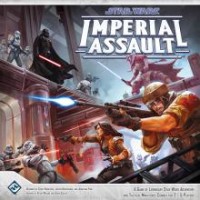
It’s time to head into a galaxy far, far away!
With Star Wars: The Force Awakens hitting movie theaters this week, we couldn’t wait any longer to post our review of Star Wars: Imperial Assault.
You may have seen mentions of the game pop up on our site before now. We’ve included it in our 2015 Board Game Gift Guide as well as in Dad’s 20 Favorite Board Games list. And now it’s time to dive into it.
I’ve actually been chomping at the bit to review Imperial Assault for a number of months since it’s such a great board game.
When I first heard that Fantasy Flight Games was making Imperial Assault, I was super excited for a number of reasons.
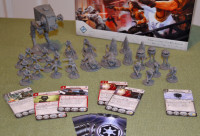
First of all, Fantasy Flight makes amazing games. They’re top notch in the quality of both the components as well as the game play.
Second, the game play is similar to Descent: Journeys in the Dark 2nd Edition – which is one of our boys and my most-played games the last couple of years. The semi-cooperative, campaign style play is a favorite for our boys as they team up as heroes to take me on as the overlord in a varied series of quests and encounters. Caleb would play it every day if he could.
Third, it’s Star Wars!
Of course that’s not reason enough to get excited for a game because many of the gazillion Star Wars-themed games are mediocre (just throwing on a Star Wars name to increase sales). But because of the first two points above, I had a good hunch that a Star Wars tie-in for this game experience would be a hit.
And I’m happy to report that it succeeds!
How to play Star Wars: Imperial Assault
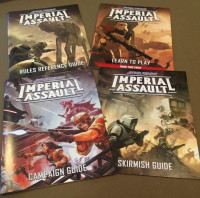
It almost goes without saying that Imperial Assault is based on the vast Star Wars universe of characters, locations, and adventures.
The introduction goes as follows: “Victory! With the destruction of the Death Star, the Rebellion has given hope to a galaxy living in fear. Having lost their ultimate weapon, the Empire scrambles to recover in the face of this crushing defeat. As the scattered fragments of the battle station rain down upon the Rebel base on Yavin 4, the Empire sets in motion a plan to seek retribution against Rebel forces stationed on the small moon. Not long after, when an Imperial beacon begins to broadcast from an outpost some distance away from the Rebel base, a small team of elite operatives is dispatched; their mission: to silence the signal at all costs…”
One of the best things about Imperial Assault is that it includes 2 games in 1!
There are two different ways to play the game: Campaign Mode and Skirmish Mode. And we’ll cover each ever so briefly.
CAMPAIGN MODE
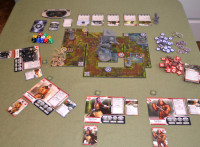
In the campaign mode of Imperial Assault, one player controls the forces of the Galactic Empire and the other players, working together, control the forces of the Rebel Alliance. Throughout the game, both sides collide during a series of missions to determine the fate of the galaxy.
The first things to become familiar with are the Rebel Hero sheets and Empire Deployment cards. These are the cards that indicate the abilities of each figure. They indicate things such as health, endurance, speed/movement, weapons, defense, and special abilities.
Each Hero also has a set of Hero Class cards that will allow them to level-up their character during a campaign – gaining new powers along the way. Lest the Empire be left behind, there are also Imperial Class cards that improve capabilities for the Empire as a campaign progresses.
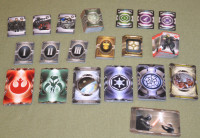
There are also plenty of other decks of cards such as Mission cards, Agenda cards, Item cards, Supply cards, Reward cards, Command cards, and Condition cards. Each of these comes into play during different parts of the adventures. When first playing the game, it will take a while to get familiar with which cards are which. The good news is that the rulebooks are good at explaining the various elements.
In addition to the cards, there are many different types of tokens that represent different game effects or objectives – such as Damage, Strain, Conditions, crates, objectives, and such.
And of course, there are 50 double-sided, interlocking map tiles of various shapes that can be put together to make a seemingly endless variety of Star Wars environments.
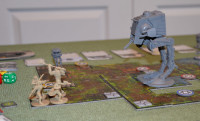
Now on to the Campaign missions.
All of the missions take place on modular and unique maps. Each mission has it’s own special rules and objectives for the different sides to complete. We won’t go into details about the specific campaign missions themselves (since there are 30 missions). Instead, we’ll cover the basic game play of the campaign.
During campaign missions, the Imperial player will know every secret that awaits as the mission progresses. That player will set up each mission. The Rebels will only know their next objective – meaning there will be some surprises waiting for them. For example, the Rebels may discover Imperial codes behind a door, but they won’t know if the codes are unguarded or if the open door will reveal a squad of stormtroopers. It makes for some fun twists.
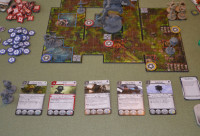
Missions are played over a number of game rounds consisting of two phases:
1. Activation Phase: Play alternates back and forth, starting with the Rebel players activating one of their figures and resolving two actions, such as moving and attacking. Then the Imperial player activates all figures corresponding to one of their troop groups – each figure of the group resolving two actions. Players continue taking turns like this until all figures have been activated once.
2. Status Phase: After resolving all the figure activations, there are a number of “cleanup” steps during this phase.
After resolving the Status Phase, play proceeds to the next round. The phases are repeated until one side achieves their objective and the mission ends.
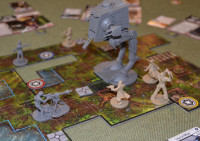
As you can see, the Activation Phase is where all the action takes place. When a player activates a figure, they can perform the following actions:
- Move: The figure gains movement points equal to their Speed (indicated on their card) and can move up to that many spaces on the map (either orthogonally or diagonally). They can also suffer Strain to move extra spaces.
- Interact: The figure can open an adjacent door or crate or interact with another token.
- Rest: Heroes will take on Strain during a mission. By Resting, the heroes can recover Strain and sometimes recover Damage as well. Only heroes can Rest.
- Special: Many Class cards, abilities, and mission rules allow figures to perform unique actions. Each special action can only be performed once per activation.
- Attack: As the name implies, by using this action, figures can attack enemy figures. Attacking is the main way to damage the enemy. And it’s definitely the most fun action of the whole game.
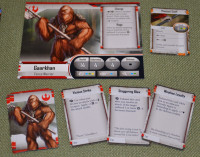
During an Attack action, both sides roll dice (offense and defense). First the attacking player chooses an enemy figure to attack with their weapon (either Ranged or Melee) and checks the line of sight (to make sure they can see the target).
They then roll the color and amount of Attack dice listed on their Deployment card or Hero sheet (taking into account any special ability cards). The defending player rolls defense dice (also listed on their card or sheet). Then they compare the results.
Since I can’t really write the different symbols in text format, you’ll have to just check out the photos.
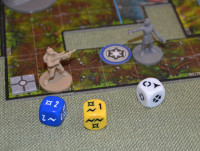
- Surge (lightning symbol) will trigger some special abilities.
- Evade (circular symbol) cancels an enemy Surge.
- Dodge (X symbol) means the attack misses.
- Numbers indicate the accuracy/distance that a ranged attack can hit.
- Damage (blast symbol) in excess of Block (triangle symbol) indicates how much damage the target suffers. Figures that take damage place that many damage tokens on their Hero sheet or next to the damaged Imperial figure.
When a figure has suffered damage equal to its Health, it is defeated. When any Imperial figure is defeated, it’s removed from the map. When the last figure in a group is defeated, the corresponding Deployment card is returned to the Imperial player’s hand.
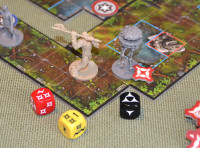
When a hero is defeated for the first time during a mission, he discards all damage tokens from his Hero sheet and flips his Hero sheet to the Wounded side – which will limit their abilities for the rest of that mission. If a Wounded Hero is defeated, their figure is removed from the map and is eliminated from the mission (not campaign).
As soon as the end condition of the mission is met, the Imperial player resolves the End of Mission section of the mission rules.
In addition, players have opportunity to purchase new Item cards, Class cards, and Agenda cards that will help them in the rest of the missions of the campaign. There are a few other things to do between missions as well, but we’ll let you discover those when you play. Suffice it to say that your characters will get better and the battles more intense as you go through a full campaign.
It’s awesome!
But that’s not all…
SKIRMISH MODE
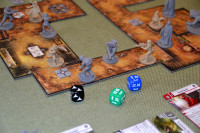
In addition to the Campaign mode, Imperial Assault includes a Skirmish mode that pits 2 players against one another in head-to-head Star Wars skirmishes. And it’s a blast to play!
The objective in a skirmish game is to acquire points by defeating enemy figures and fulfilling the mission objectives. It uses the same foundational rules as we’ve described previously (such as for activating, moving, and attacking).
There’s also an Introductory Skirmish listed in the rules to help new players become familiar with the rounds in a skirmish mission.
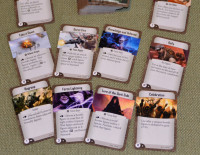
In a skirmish, players build their own personalized armies to lead into battle. Army building has players not only choose the figures in their armies, but also which Command cards they wish to use.
Using different combinations of figures and Command cards is what generates so much variety and thus replayability of Star Wars: Imperial Assault in Skirmish mode. And players don’t even have to choose different sides in a skirmish. If they want, players can both control Imperial armies!
When building an army, players won’t have any foreknowledge of the opponent’s army or the mission they’ll be playing. Each player will have 40 deployment points to use for choosing which characters/figures to deploy into the battle (shown in the upper left corner of Deployment cards).
At the start of a skirmish, each player also creates a deck of exactly 15 Command cards and the total cost of the Command cards must be 15 or fewer (number on the bottom left of the Command card).
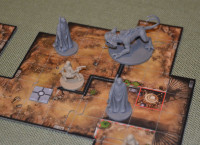
Players then deploy their armies into the Red or Blue Deployment zones on the Skirmish map chosen (simply follow the steps in the Skirmish Guide book) and draw 3 of their Command cards into hand. This is the first glimpse that opponents will have of one another’s armies.
The Activation Phase of each round is very similar to the Campaign mode with just a few differences. For starters, figures can’t Rest. And if a figure suffers Strain during a skirmish, they really just take Damage instead. Or they can discard a Command card to prevent taking a Damage token. Also figures can also only use one of their actions to Attack.
The Status Phase also has a few differences. For example, each player will draw 1 Command card into their hand plus 1 additional card for each terminal they control. There may also be some End of Round effects that will trigger – depending on the Skirmish mission.
Command cards are used during turns for special effects or abilities. There is no limit to the number of Command cards a player can have in hand. And there is no limit to the number of cards a player can play on a turn. So battles can take on new depth and twists during a skirmish.
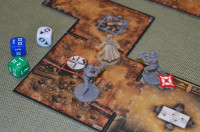
During a skirmish, all figures are removed from the map when defeated – unlike during a Campaign when Heroes can turn over their Hero sheet to the Wounded side.
The skirmish ends as soon as one player has accumulated 40 victory points (VPs).
Players gain VPs by defeating figures and through card and mission effects. When the last figure of a group is defeated, the opposing player scores VPs equal to that group’s deployment cost. If all of a player’s figures are defeated then they lose the game immediately.
Like I mentioned earlier, the Skirmish mode is a blast. We highly recommend playing it.
Cool things about Star Wars: Imperial Assault
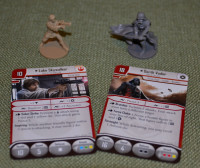
1. Of course the first noticeable cool thing about Imperial Assault is the fantastic components and awesome miniatures. Fantasy Flight Games always does fantastic work with miniatures and Imperial Assault is no different. The only downside in this regard is that many cool figures are sold separately.
In regards to miniatures, the base game comes with 34 figures. There are also 12 Ally and Villain tokens. If you want to upgrade those tokens to figures, you can, but you’ll have to buy them separately. For example, if you want C-3PO or R2-D2, you’ll need to buy their Ally pack.
2. We’ve already mentioned one of the cool things about Imperial Assault – the addition of a Skirmish mode. The Campaign mode is great, but sometimes we just don’t have enough people to delve into a campaign. With Skirmish mode available, if there are only two of us wanting to play, we can!
(Granted that even with just 2 players you can still play campaign mode – with one player controlling multiple Rebel heroes. But Campaign mode is more fun with more players.)
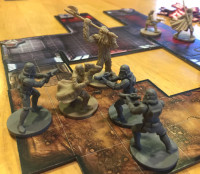
3. Imperial Assault also includes a Tutorial Mission so players can get familiar with the game play – flow and mechanics before diving in to a campaign or skirmish. The Tutorial encounter is a simple map with straight-forward objectives and it only takes a few turns to complete. But it’s enough to get a taste for the game and get excited for more.
Since we have a lot of experience in this type of game play because of Descent, the Tutorial was very helpful because it allowed us to learn the differences between the two games.
4. Another simple but cool thing is how turns are taken in Campaign mode. In Descent, hero players would all take their turns and then the overlord would activate every group of monsters. But in Imperial Assault one Rebel player takes a turn, then the Empire player activates one of his troop groups, then another Rebel player goes, then a different Empire group activates, etc.
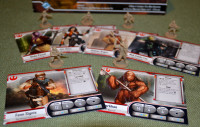
These back and forth turns allow for a more fluid battle experience that we really enjoy.
5. And the last cool thing we’ll mention is the vast array of experiences yet to come. Knowing Fantasy Flight Games as well as being familiar with these type of games, it was obvious from the very start that a bunch of expansions would follow. Sure enough, within the first year of Imperial Assault being out, there are already a couple of expansions available. And rest assured that more will follow.
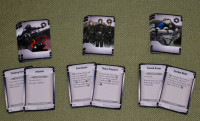
After all, this is Star Wars and the universe is vast. There are plenty of fun adventures yet to come.
Of course, there are plenty of other things we really like about the game play of Imperial Assault (like Allies, how Strain works, how figures Move, attribute tests, items, conditions, special abilities, and more). But we don’t have time and space to go into all of them.
Suffice it to say that we highly recommend this game and that you can discover those cool things for yourself by playing.
How does Star Wars: Imperial Assault score on our “Let’s Play Again” game meter?
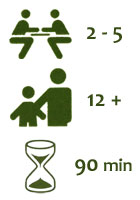 With so many tiles, figures, cards and tokens, Star Wars: Imperial Assault may take a while to set up, but once everything is out, it’s super compelling to play multiple battles. Just like when we play a Descent campaign, once a campaign begins, the game remains on the table for days or weeks so it’s easier to sit down and play the next encounter when we get the chance.
With so many tiles, figures, cards and tokens, Star Wars: Imperial Assault may take a while to set up, but once everything is out, it’s super compelling to play multiple battles. Just like when we play a Descent campaign, once a campaign begins, the game remains on the table for days or weeks so it’s easier to sit down and play the next encounter when we get the chance.
And let’s not forget the Skirmish mode. The myriad combinations of figures and Command cards also leads to a lot of “let’s play again” moments.
Of course, the gals in our family wouldn’t rate it very high on our “let’s play again” game meter. But that’s only because they haven’t played it a single time yet. They’re not into Star Wars as much. They also prefer games with less components and things to learn. They’re happy to leave this Star Wars universe and adventures to us boys.
Now, enough writing, it’s time to dive back into some playing.
May the Force be with you!
Pick up a copy of Star Wars: Imperial Assault

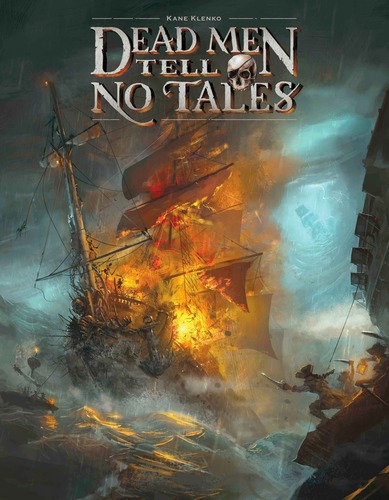
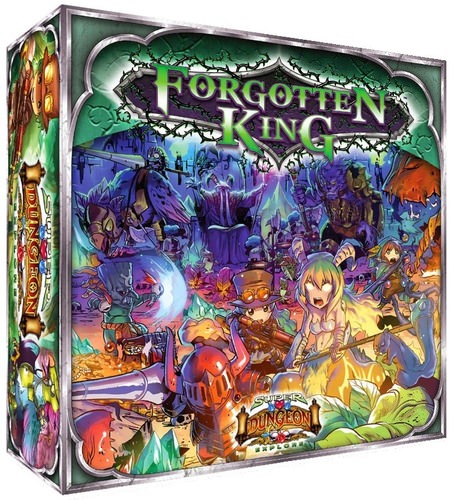
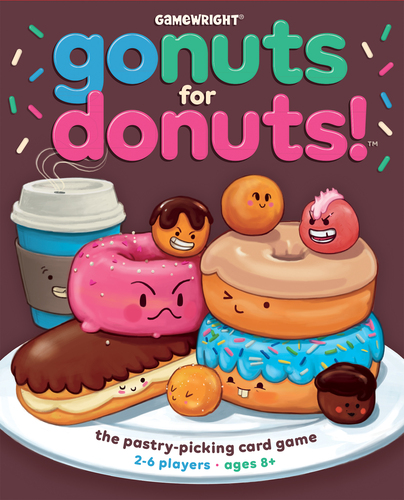
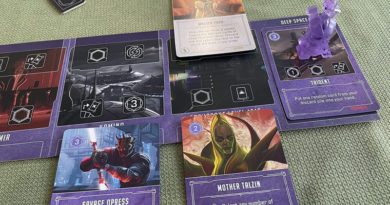
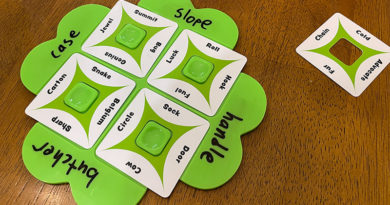
Thanks for the very thorough review! Would you say that this game then improves on Descent: Journeys in the Dark 2nd Ed in every way? Are there aspects of Descent that are missing from Imperial Assault? It sounds like the mechanics of this game improve on and offer more options? Does the fantasy vibe of Descent allow more variety than Imperial Assault (which is married to SW cannon)? Appreciate your thoughts since you have spent a lot of time playing both. Thank you.
Luna,
In regards to the mechanics, Yes, Imperial Assault does improve upon them across the board. The back-and-forth nature of turns being the biggest change and improvement. Then the addition of a Skirmish mode takes it over the top with replay value.
That being said, as much as we love Star Wars, the boys still favor Descent because of the fantasy nature of it. Like you suggest, the openness of the fantasy realm is what they love over feeling a bit limited with just SW cannon. That being said, SW will grow to be more wide open as well.
Thanks for the rapid response Trent. I guess there would be nothing to stop you incorporating the mechanics of Imperial Assault to give the back-and-forth nature, skirmish mode, etc. into a Descent game now you know the format….or is that not the case?
I think incorporating the back-and-forth turn plays in a campaign could work in Descent. But the skirmish mode isn’t as transferable.